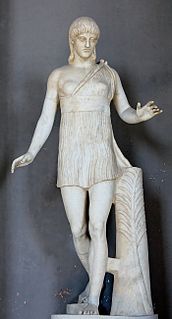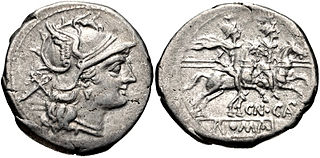In Greek mythology, Aethalides was a son of Hermes and Eupolemeia, a daughter of Myrmidon.
In Greek mythology, Phemonoe was a Greek poet of the ante-Homeric period. She was said to have been the daughter of Apollo, his first priestess at Delphi, or of his possible son Delphus, and the inventor of the hexameter verses, a type of poetic metre. In some studies, attributed to the phrase "know thyself" found inscribed at the entrance to the Temple of Apollo at Delphi. Some writers seem to have placed her at Delos instead of Delphi; and Servius identifies her with the Cumaean Sibyl. The tradition which ascribed to her the invention of the hexameter, was by no means uniform; Pausanias, for example, as quoted above, calls her the first who used it, but in another passage he quotes an hexameter distich, which was ascribed to the Pleiades, who lived before Phemonoe: the traditions respecting the invention of the hexameter are collected by Fabricius. There were poems which went under the name of Phemonoe, like the old religious poems which were ascribed to Orpheus, Musaeus, and the other mythological bards. Melampus, for example, quotes from her in his book Peri Palmon Mantike §17, §18; and Pliny quotes from her respecting eagles and hawks, evidently from some book of augury, and perhaps from a work which is still extant in MS., entitled Orneosophium. There is an epigram of Antipater of Thessalonica, alluding to a statue of Phemonoe, dressed in a pharos.
In Roman mythology, the Aeneads were the friends, family and companions of Aeneas, with whom they fled from Troy after the Trojan War. Aenides was another patronymic from Aeneas, which is applied by Gaius Valerius Flaccus to the inhabitants of Cyzicus, whose town was believed to have been founded by Cyzicus, the son of Aeneas and Aenete. Similarly, Aeneades was a patronymic from Aeneas, and applied as a surname to those who were believed to have been descended from him, such as Ascanius, Augustus, and the Romans in general.
Julius Africanus was a celebrated orator in the reign of Nero, and seems to have been the son of the Julius Africanus, of the Gallic state of the Santoni, who was condemned by Tiberius in 32 AD. Quintilian, who had heard Julius Africanus, spoke of him and Domitius Afer as the best orators of their time. The eloquence of Africanus was chiefly characterized by vehemence and energy. Pliny the Younger mentions a grandson of this Julius Africanus, who was also an advocate and was opposed to him upon one occasion. He was consul suffectus in 108 AD.

Pasiteles was a Neo-Attic school sculptor from Ancient Rome at the time of Julius Caesar. Pasiteles is said by Pliny to have been a native of Magna Graecia, and to have been granted Roman citizenship. He worked during a period where there was a demand for copies of, or variations on, noted works of Greek sculpture; the demand was met by the workshops of Pasiteles and his pupils Stephanus and Menelaus and others, several of whose statues are extant. According to Pliny, Pasiteles made an ivory statue of Jupiter for the temple of Metellus and made statues for the temple of Juno in the portico of Octavia.
Archon was a Pellaean, appointed satrap of Babylonia after the death of Alexander the Great in 323 BC. He is probably the same as the son of Cleinias mentioned in the Indian expedition of Alexander. He perished in 321 in a fight against Docimus. An inscription in Delphi shows that Archon had taken part in both the Isthmian and Pythian Games of 333-332, winning some horse-races.

The gens Calpurnia was a plebeian family at Rome, which first appears in history during the third century BC. The first of the gens to obtain the consulship was Gaius Calpurnius Piso in 180 BC, but from this time their consulships were very frequent, and the family of the Pisones became one of the most illustrious in the Roman state. Two important pieces of Republican legislation, the lex Calpurnia of 149 BC and lex Acilia Calpurnia of 67 BC were passed by members of the gens.
Minucius Acilianus was born in Brixia, and was the son of Minucius Macrinus, who was enrolled by Vespasian among those of praetorian rank. Like his father, he was also a friend of Pliny the Younger. Acilianus was successively quaestor, tribune, and praetor, and at his death left Pliny part of his property.
Minucius Macrinus was a friend of Pliny the Younger, to whom the latter addressed many of his Epistles, but of whose life we have no particulars, other than that he had a son, Minucius Acilianus, who was also a friend of Pliny's.
Arrianus was a Roman jurisconsult of uncertain date. He probably lived under Trajan, and, according to the conjecture of Grotius, is perhaps the same person as the orator Arrianus, who corresponded with Pliny the Younger. He may also possibly be identical with the Arrianus Severus, praefectus aerarii, whose opinion concerning a constitution Divi Trajani is cited by Aburnus Valens. He wrote a treatise de Interdictis of which the second book is quoted in the Pandects in an extract from Ulpian. In that extract, Proculus, who lived under Tiberius, is mentioned in such a manner, that he might be supposed to have written after Arrianus. There is no direct extract from Arrianus in the Pandects, though he is several times mentioned.
Phradmon was a little-known sculptor from Argos, whom Pliny places as the contemporary of Polykleitos, Myron, Pythagoras, Scopas, and Perelius, at Olympiad 90 in 420 BCE, in giving an anecdotal description of a competition for a Wounded Amazon for the temple of Artemis at Ephesus: in Pliny's anecdote, the fifth place was won by Phradmon, whom Pliny admits was younger than any of the four who were preferred to him. Trusting in Pliny's anecdote, scholars have often hopefully assigned the "Lansdowne" type of Wounded Amazon to Phradmon.
Timasitheus was an athlete of Delphi, who was victorious several times in the pankration at the Olympic and Pythian Games, and was also distinguished as a brave soldier.
Pythagoras of Samos or Pythagoras of Rhegion, was a statuary from Samos whom Pliny the Elder expressly distinguishes from the more renowned Pythagoras from Rhegion. Pliny does however say that the sculptor bore a remarkable personal likeness to the mathematician. There is no precise indication of his date. Philip Smith accepted the opinion of Karl Julius Sillig (1801—1855) that Pliny's date of Olympiad 87 ought to be referred to this artist rather than to a different Pythagoras, from Rhegium; other writers consider it possible he lived closer to the beginning of the 5th century BC. Modern writers consider it certain these two were the same artist, and that this Pythagoras was one of the Samian exiles who moved to Zankle at the beginning of the 5th century BC and came under the power of the tyrant Anaxilas in Rhegium. While a Samian by birth, he was a pupil of Clearchus of Rhegium.
Agenorides is a patronymic of Agenor, designating a descendant of any one of the ancient Greeks who was named Agenor, but usually used to describe only the descendants of Agenor, such as Cadmus, Phineus, and Perseus.
Aleuas or Alevas can refer to more than one person from ancient Greek myth and history:
Alexis was an ancient Greek sculptor and statuary, mentioned by Pliny as one of the pupils of Polykleitos. Pausanias mentions an artist of the same name, a native of Sicyon, and father of the sculptor Cantharus. It cannot be satisfactorily settled whether these are the same, or different persons. Pliny's account implies that he had the elder Polykleitos in mind, in which case Alexis could not have flourished later than Olympiad 95 in 400 BC, whereas Eutychides, under whom Cantharus studied, flourished about Olympiad 120 in 300. If the two were identical, as German classicist Friedrich Thiersch thinks, we must suppose either that Pliny made a mistake, and that Alexis studied instead under Polykleitos the Younger, or else that Eutychides, whose date is given by Pliny, was not the artist under whom Cantharus studied.
Gaius Calpurnius Piso was a Roman praetor and promagistrate.
Calpurnius Fabatus was an Ancient Roman nobleman (eques) of the 1st century AD from the gens Calpurnia.
Declamation is an artistic form of public speaking. It is a dramatic oration designed to present through articulation, emphasis and gesture the full sense of the message being imparted.
The gens Laenia was a minor family at Rome during the first century BC. It is remembered chiefly from two individuals, one a friend of Varro, the other of Cicero. Both had houses at Brundisium, suggesting either that the family came from that region, or that the individuals mentioned were closely related.







